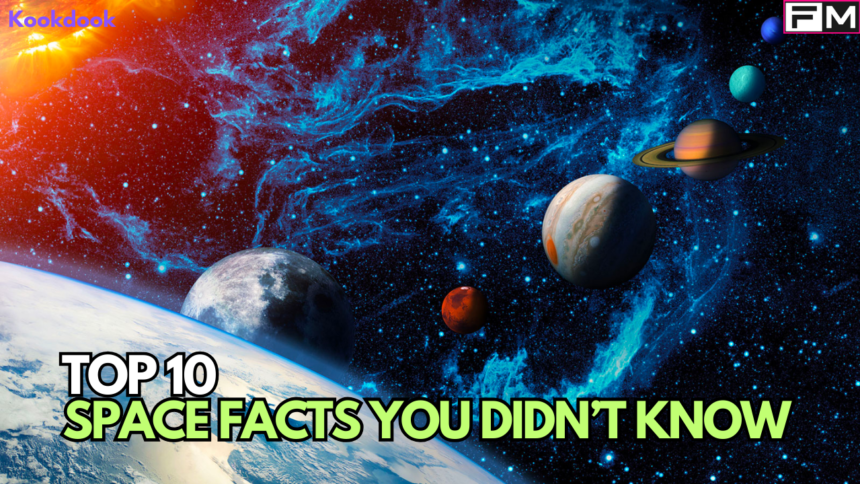This article is here to tell you some amazing things about space that you might not know. We’re going to rank the Top 10 Space Facts about space for you.
The Milky Way is Huge
Our galaxy, the Milky Way, is enormous. It’s about 105,700 light-years in diameter and is home to billions of stars and planets. Traveling to its center in a spaceship would take a staggering 450 million years!
| Space Facts | Key Points |
|---|---|
| Mercury Has No Moons | – Mercury and Venus have no natural moons, unlike other planets. |
| – Astronomers are still exploring why these two planets lack moons. | |
| Venus is the Hottest Planet | – Venus, not Mercury, is the hottest planet due to its thick atmosphere. |
| – The “Greenhouse Effect” traps heat, maintaining a sizzling temperature. | |
| Black Holes and Stars | – Black holes can tear apart stars that venture too close. |
| – Gravitational redshift occurs as the star’s light loses energy. | |
| Our Solar System’s Age | – Our solar system is a staggering 4.57 billion years old. |
| – The Sun will turn into a Red Giant in about 5 billion years. | |
| Reflective Moon, Enceladus | – Saturn’s moon Enceladus reflects over 90% of sunlight, making it exceptionally bright. |
| – Despite its brightness, it’s smaller compared to other moons. | |
| Tallest Volcano on Mars | – Mars houses the solar system’s tallest volcano, Olympus Mons. |
| – Olympus Mons is three times taller than Mount Everest. | |
| First Spiral Galaxy | – The Whirlpool Galaxy, or Messier 51, was the first spiral galaxy discovered. |
| – It’s located about 31 million light-years away from Earth. | |
| Understanding Light-Years | – A light-year represents the distance light travels in one Earth year (about 6 trillion miles). |
| – It’s used for measuring vast cosmic distances. | |
| The Vastness of the Milky Way | – The Milky Way galaxy is 105,700 light-years in diameter. |
| – It’s home to billions of stars and planets, with a long journey to its center. | |
| The Sun’s Immense Mass | – The Sun is 330,000 times heavier than Earth and contains most of the solar system’s mass. |
| – In the distant future, the Sun will expand and engulf Earth in about 7.5 billion years. |
The Sun is Super Heavy
The Sun is incredibly heavy – about 330,000 times heavier than Earth. It holds nearly all the mass in our solar system. It’s so massive that Earth could fit inside it over a million times. Eventually, it will expand and swallow Earth in about 7.5 billion years.
Mercury Doesn’t Have Any Moons
Mercury, one of the planets in our solar system, doesn’t have any moons. This is quite unusual because most planets do have moons, some even more than one. Astronomers are still trying to figure out why Mercury and its neighbor, Venus, don’t have any moons.
Venus Takes the Crown for Hottest Planet
Even though Mercury is closest to the Sun, it’s not the hottest planet. Venus claims that title. It’s scorching due to its thick atmosphere filled with carbon dioxide and sulfuric acid clouds. This traps heat, making Venus feel like an oven. It’s so hot that even lead would melt there!
Black Holes Can Tear Apart Stars
Astronomers have seen black holes tear apart stars that ventured too close. This happens because the intense gravity of a black hole pulls the star apart, a phenomenon known as “gravitational redshift.”
Our Solar System is Really, Really Old
Our solar system has been around for a staggering 4.57 billion years. That’s older than anything you can imagine. In about 5 billion years, our Sun will turn into a Red Giant, but that’s a long way off.
Saturn’s Moon, Enceladus, is Super Reflective
One of Saturn’s moons, Enceladus, is incredibly shiny. It reflects over 90% of the sunlight that hits it, making it one of the brightest objects in our solar system. It’s not very big, though, compared to some other moons.
Mars Has the Tallest Volcano
Mars boasts the tallest volcano in the entire solar system – Olympus Mons. It’s about 16 miles high and 310 miles wide, which is roughly the size of Arizona. That’s three times taller than Mount Everest!
The First Spiral Galaxy Discovered is the Whirlpool Galaxy
The Whirlpool Galaxy, also known as Messier 51, was the first spiral galaxy ever discovered. It’s about 31 million light-years away and has those beautiful spiral arms you’ve probably seen in pictures.
Space is both mysterious and amazing. Exploring it helps us understand our place in the universe and how it all came to be. These facts might change as we continue to learn more about space, but that’s the beauty of science – it’s always evolving. So, keep looking up at the night sky and never stop learning about the wonders of space!






